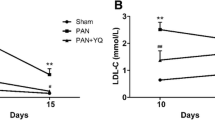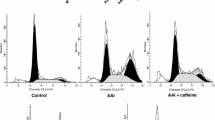Abstract
Background. Although Aristolochia manshuriensis (AM), which was incriminated in the Japanese variety of Chinese herbs nephropathy, has been recently shown to be nephrotoxic in rats, less is known about whether this toxicity is attributable to its aristolochic acids (AA). We compared the renal effect of AM with that of Akebia quinata (AQ), which has similar components to AM but is free of AA; we also compared this effect of AM with that of pure AA, and studied its possible mechanism.
Methods. In study 1, rats were divided into four groups. Each group was orally given either 0.4 g of AM, 4 g of AM, or 4 g of AQ per day, or vehicle, for 5 days. In study 2, rats were given 4 g of AM (which contained 4 mg of AA), or 4 mg of pure AA per day, or vehicle, for 5 days. Renal function, and renal histology were evaluated on day 5 in study 1 and on days 1, 3, 5, and 14 in study 2. In study 2, terminal deoxynucleotidyl transferase-mediated dUTP-biotin nick end-labeling (TUNEL) and proliferating cell nuclear antigen (PCNA) staining were also performed. In study 3, rats were treated in the same way as in study 2, but were all killed on day 5. Concentrations of AA (I + II) were measured in serum and urine in study 2, and in the kidney, lung, heart, liver, and spleen in study 3.
Results. In study 1, only the rats that received 4 g/day of AM developed tubular necrosis, azotemia, proteinuria, and glucosuria. In study 2, both AM- and AA-treated rats showed progressive tubular damage, decreased renal function, and increased urinary protein excretion. The degree of these alterations was comparable in the AM and AA groups. Moreover, the concentrations of AA (I + II), in serum, urine, and kidney were also comparable in the AM- and AA-treated rats. High levels of AA were detected in the lung and kidney. Apoptotic tubular cells increased on day 5 and had decreased by day 14 after the withdrawal of AM or AA. Meanwhile, proliferating tubular cells progressively increased from day 3 to day 14.
Conclusions. Our study indicates that the renal toxicity of AM can be attributed to its AA component. Tubular cell apoptosis might be one of the mechanisms involved in this renal injury.
Similar content being viewed by others
Author information
Authors and Affiliations
Corresponding author
Additional information
Part of this study was presented at the 43rd Annual Meeting of the Japanese Society of Nephrology (May 2000, Nagoya, Japan) and at the ASN/ISN World Congress of Nephrology (October 2001, San Francisco, USA).
About this article
Cite this article
Liu, MC., Maruyama, S., Mizuno, M. et al. The nephrotoxicity of Aristolochia manshuriensis in rats is attributable to its aristolochic acids. Clin Exp Nephrol 7, 186–194 (2003). https://doi.org/10.1007/s10157-003-0229-z
Received:
Accepted:
Issue Date:
DOI: https://doi.org/10.1007/s10157-003-0229-z




